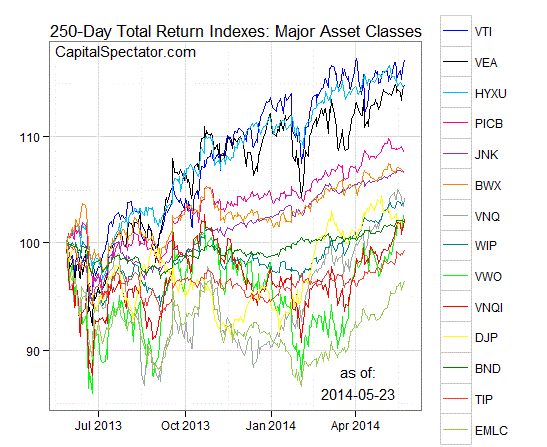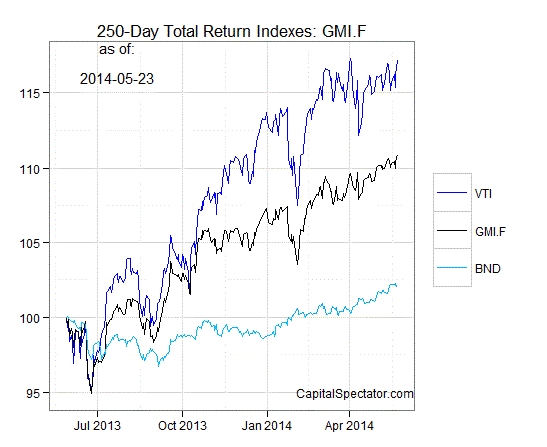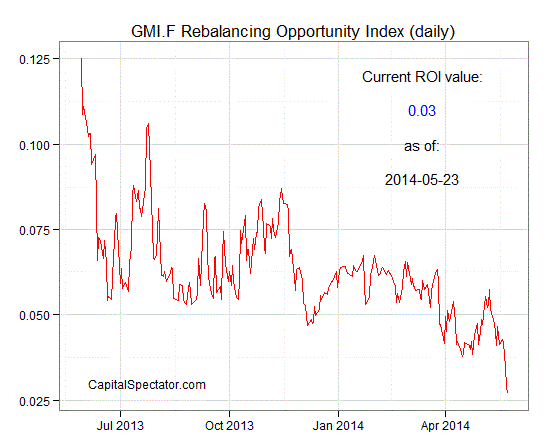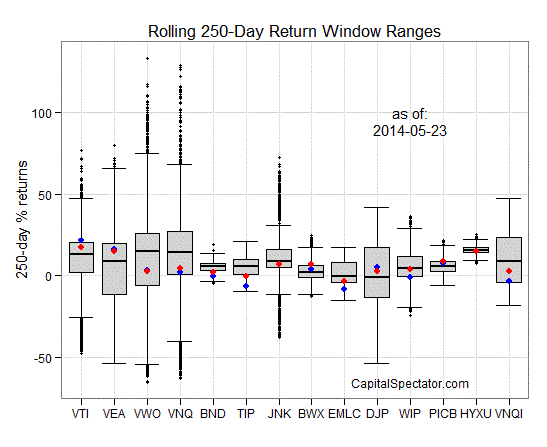There’s a bullish tailwind blowing across the major asset classes at the unofficial start of summer. But there’s a new feature to the current rally. Compared with the previous update in April, the range of returns at the moment is less extreme compared with recent history. There’s also less red ink weighing on our standard list of ETF proxies via 250-trading-day windows (the rough equivalent of 1-year returns). Take note too that of the declines that remain, the losses are relatively slight these days.
One thing that hasn’t changed: US stocks (Vanguard Total Stock Market (ARCA:VTI)) still dominate, posting a 17.2% advance for the trailing 250-day trading period, although the lead isn’t quite as extreme as it had been earlier this year. Meantime, at the bottom of the list: emerging-market government bonds (MarketVectors EM Local Curr. Bond (NYSE:EMLC)). This slice of the fixed-income market is down 3.5%, but that’s a major improvement after a strong rally in recent months.
For a graphical recap, consider the relative performance histories for each of the major asset classes for the past 250 trading days by way of the ETF proxies. The chart below shows the performance records through May 23, 2014, with all the ETFs rebased to 100 using a start date of May 29, 2013:
Now let’s review an ETF-based version of a passive, market-value-weighted mix of all the major asset classes–the Global Market Index Fund, or GMI.F, which is comprised of all the ETFs in the table above. Here’s how GMI.F stacks up for the past 250 trading days through May 23, 2014. This investable strategy has climbed 10.9% over that time frame, or roughly midway between the returns for US stocks (VTI) and US bonds (BND).
Comparing the overall dispersion of returns for the major asset classes via ETFs suggests that the rebalancing opportunity is relatively low for GMI.F overall vs. recent history. Indeed, thanks to the general rise of prices for all the ETF proxies lately, the performance spread for these funds has fallen sharply in recent weeks. Analyzing the components of GMI.F with a rolling median absolute deviation of one-year returns for all the funds–the GMI.F Rebalancing Opportunity Index, as it’s labeled on these pages–suggests that there’s minimal potential generally for adding value by reweighting this portfolio in comparison with the past 12 months. Keep in mind that the opportunity for productive rebalancing will vary depending on the choice of holdings and historical time window. Meantime, don’t overlook the possibility that any given pair of ETFs may present a substantially greater or lesser degree of rebalancing opportunity vs. analyzing GMI.F’s components collectively.
Finally, let’s compare the rolling 1-year returns (250-trading-day performance) for the ETFs in GMI.F via boxplots for a revealing comparison of price momentum across the board. The gray boxes in the chart below reflect the middle range of historical 250-day returns for each ETF—the 25th to 75th return percentiles. The red dots show the current return (as of May 23) vs. the 250-day return from 30 trading days earlier (blue dots, which may be hiding behind the red dots in some cases). In most cases, the current 250-day return is at or above the comparable return from 30 days ago. The main exceptions at the moment: US equities (VTI) and commodities (iPath DJ-UBS Commodity Index TR (NYSE:DJP)), which post lower but still positive returns compared with 30 days earlier.





